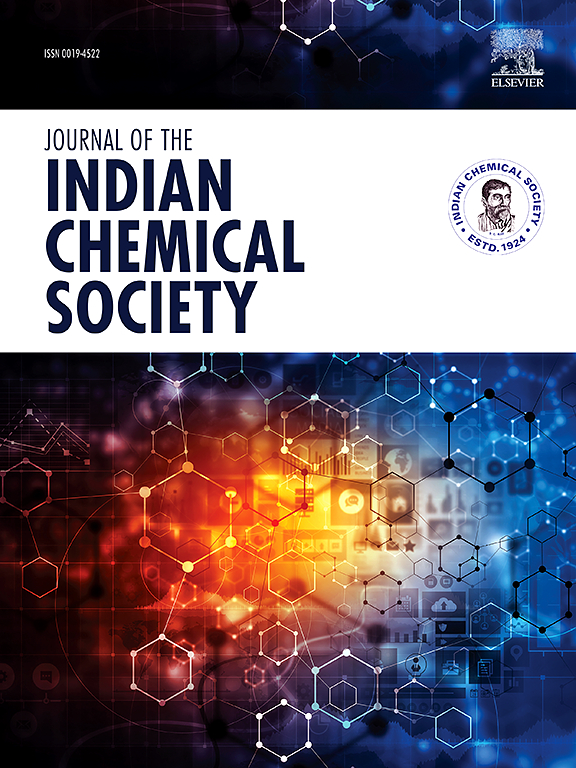Magnetic and supercapacitor applications of LiFe2O4 nanoparticles through sol-gel auto-combustion technique with theoretical representation
IF 3.2
4区 化学
Q2 CHEMISTRY, MULTIDISCIPLINARY
引用次数: 0
Abstract
The article explores the synthesis of lithium ferrite nanoparticles (LiFe2O4) using the sol-gel auto-combustion process. The synthesized nanoparticles were characterized by X-ray diffraction, Field Emission Scanning Electron Microscope, High Resolution Transmission Electron Microscope, Fourier Transform Infrared, Vibrating Sample magnetometer and Cyclic Voltammetry techniques. X-ray diffraction showed that the single-phase lithium ferrite nanoparticles with a crystallite size of 35 nm. FT-IR spectra revealed that the vibrational assignments which is absorption metal ranges for tetrahedral and octahedral sites. The FE-SEM images of LiFe2O4 owed cubical particle with minimal agglomeration. The recorded HR-TEM analysis of LiFe2O4 revealed a polycrystalline nature with layered morphology. The selected area electron diffraction pattern indicates that distinct ring formation which confirming the single-phase cubic structure. The VSM measurements have confirmed that the saturation magnetization, remanence and coercivity of single-phase lithium ferrite nanoparticles were determined to be 43emu/g, 21emu/g and 9 Oe, respectively. Cyclic voltammetry study reveals the specific capacitance value of 201 Fg-1 observed at a scanning rate of 2 mVs−1. The theoretical estimation was carried out by Density Functional Theory method. The title compound's NLO characteristics were calculated using first-order hyperpolarizability. The energy gap between HOMO and LUMO demonstrates that charge moves within the molecule. The MEP and Mulliken charges were calculated and analyzed.
溶胶-凝胶自燃烧技术在LiFe2O4纳米颗粒磁性和超级电容器中的应用
研究了溶胶-凝胶自燃烧法制备铁酸锂纳米颗粒(LiFe2O4)。采用x射线衍射、场发射扫描电镜、高分辨率透射电镜、傅里叶变换红外、振动样品磁强计和循环伏安法等技术对合成的纳米颗粒进行了表征。x射线衍射结果表明,制备出晶粒尺寸为35 nm的单相铁氧体锂纳米颗粒。傅里叶变换红外光谱显示,在四面体和八面体的位置上,其振动分配范围为吸收金属。LiFe2O4的FE-SEM图像显示了最小团聚的立方体颗粒。记录的hrtem分析显示LiFe2O4具有层状形貌的多晶性质。选定区域的电子衍射图显示出明显的环状结构,证实了该材料的单相立方结构。通过VSM测量,确定了单相铁氧体锂纳米颗粒的饱和磁化强度为43emu/g,剩磁强度为21emu/g,矫顽力为9oe。循环伏安法研究了201 Fg-1在2 mv−1扫描速率下的比电容值。采用密度泛函理论方法进行理论估计。用一阶超极化率计算了标题化合物的NLO特性。HOMO和LUMO之间的能隙表明电荷在分子内移动。计算并分析了MEP和Mulliken电荷。
本文章由计算机程序翻译,如有差异,请以英文原文为准。
求助全文
约1分钟内获得全文
求助全文
来源期刊
CiteScore
3.50
自引率
7.70%
发文量
492
审稿时长
3-8 weeks
期刊介绍:
The Journal of the Indian Chemical Society publishes original, fundamental, theorical, experimental research work of highest quality in all areas of chemistry, biochemistry, medicinal chemistry, electrochemistry, agrochemistry, chemical engineering and technology, food chemistry, environmental chemistry, etc.

 求助内容:
求助内容: 应助结果提醒方式:
应助结果提醒方式:


